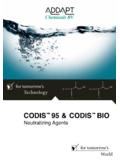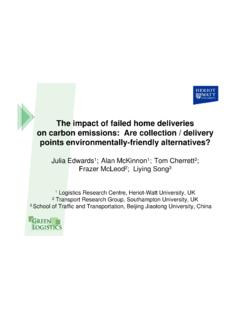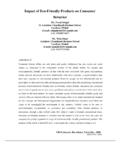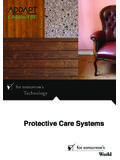Transcription of WEED CONTROL - Research Information Ltd
1 weed CONTROL . USE OF HERBICIDES ON RAILWAY TRACKS IN SWEDEN. Lennart Torstensson, of the Swedish University of Agricultural Sciences in Uppsala, outlines the methods used to clear weeds along railway tracks in Sweden Introduction Another important reason for removal of weeds from In Sweden, removal of weeds along railway lines has railway tracks is the working environment for track main- been carried out for more than 50 years by application of tenance employees. The risk of accidents caused by stumbling herbicides. The Swedish national railway network consists or slipping on weeds is obvious and may have fatal conse- in total of about 12,000 km, of which 25 30% is treated quences.
2 Annually. A specially equipped spray train (Figure 1) is used A further reason for weed removal is the risk of train by trained staff for the purpose. wheels skidding, causing longer acceleration distances and, Theoretically, there are several alternative methods of more seriously, extended braking distances, which could removing weeds from tracks, chemical, mechanical or result in the train being unable to stop at signals. thermal. Methods using hot water and steam have been If weeds on the railway embankment become dry during tested but only delayed growth effects have been achieved.
3 The summer, there is always a risk of fire caused by sparks Weeds can also be controlled for short periods using open from the wheels. In addition, the quality of wooden sleepers flames but this method is not possible on all types of track is rapidly destroyed when they are lying in polluted water- because of the fire-sensitive materials used in signal systems. saturated ballast. There is also the risk of setting fire to dry vegetation along the tracks. Other approaches for weed management on embank- Environmental concerns ments are use of impenetrable plastic layers along the sides To obtain good results from herbicide application on railway of the embankments, and strategies for establishment of embankments requires a thorough knowledge of herbicide weed competitive vegetation along the base of the establish- behaviour and persistence on and in the embankment.
4 By ments. good results is meant acceptable weed CONTROL , but also the The general opinion in Sweden is against use of pesticides absence of side-effects such as injury to employees or damage and there have been suggestions that weeds on railway to equipment or to the environment along the tracks. tracks could be removed manually. Manual removal would Chemical, physical, and toxicological properties of herbicides be possible on railway embankments where the ballast con- approved by the Swedish Chemicals Inspectorate (KemI) are sists of gravel.
5 However, apart from the manpower required, well known, but not always as applied to the environment it is a dangerous operation. weed removal has to be carried of railway embankments, which are characterized by very out on tracks without disrupting the traffic. Therefore low contents of clay and organic matter and low biological the method used must have a high capacity. Because of this activity. requirement, it is difficult to find viable alternatives to Herbicides are mainly absorbed to clay and organic chemicals. matter.
6 If these are low, implying a low adsorption capacity, The Swedish National Rail Administration (BV) has the risk of transport out of the target area is obvious. A low found that weed removal by chemical means is the only content of organic matter normally means low microbial practical and economically realistic method and overall is activity. Since the activity of microorganisms is the main factor also the least risky method. controlling decomposition of herbicides in soil, this results in slow rates of transformation and consequently long per- sistence times.
7 Why remove weeds? This means that when a herbicide is to be chosen for use One of the most important reasons for removal of weeds on a railway track it is not enough simply to be well informed from railway embankments is to retain the quality of the about any effects on weeds appearing on the embankment. It track and to ensure safe railway traffic. The macadam or is also necessary to know the binding, mobility and decom- gravel which are components of the ballast should not position of the substance in material from the embankment become polluted by weeds or decaying plant residues.
8 If this to be sure that there will be no risks to the surrounding happens, the pollutants will fill up the hollow spaces within environment. the ballast, resulting in the binding of water. During the Today, BV is investing in far-reaching experiments to winter, this water will freeze to ice and swell, thereby identify effective herbicides and methods of application that causing dislocation of the track. reduce to a minimum the risk to the surrounding environ- 16 Pe s t i c i d e O u tl o ok Fe b r u a r y 2 00 1 D O I : 1 0.
9 1 0 3 9 / b 1 0 0 80 2 l This journal is The Royal Society of Chemistry 2001. weed CONTROL . distance the plots are divided along the middle of the track. The area of a plot is then (3 25=) 75 m2. Pesticides are applied using a 3 m boom with 6 VEEJET (11010) nozzles driven by compressed air and a spray volume counted after what is expected to be the volume in a full scale equipment is mounted on a trolley and speed regulation is done by an MTR 101 engine trolley or similar (Figure 2). Each experiment should include CONTROL plots, not sprayed, between each 5th test plot or at least 4 CONTROL plots per experiment.
10 Minor field studies should be repeated at 3 10. geographically different places representing different climatic zones, different weed populations and different types of embankments with variations in particle size, pH, etc. Evaluation of herbicide effects on the weed can be done by grading in a scale from 0 to 5, where 0 is as untreated Figure 1. The train used for full scale spraying operations. The CONTROL and 5 is all vegetation dead. train consists of an engine, a staff carriage also containing The scale is relatively crude but handy for practical field equipment for recording all data concerning the spraying work.








